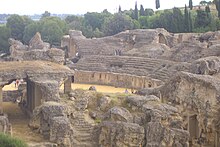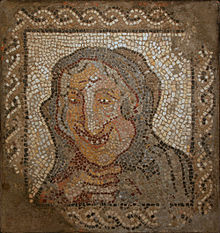Italica

Italica (Spanish Itálica ) was a Roman city in Hispania ; its ruins are in Santiponce, about ten kilometers north of Seville ( Hispalis ) on the Guadalquivir .
history
In the course of the Second Punic War , Publius Cornelius Scipio Africanus had in 206 BC Chr. After the battle of ilipa a turdetanische related settlement as a camp for wounded Roman soldiers and expand into a military post. Italica subsequently developed into an important center for the Romanization of the Iberian Peninsula . At least since Gaius Iulius Caesar , Italica had the status of a municipality .
The proximity to the Roman city of Hispalis (Seville) gave rise to considerations that Italica was a kind of official city, whereas Hispalis functioned primarily as a commercial and economic metropolis. The importance of Italica is shown by the fact that the families of the Roman emperors Trajan and Hadrian lived there. Under the latter, the city was elevated to a Colonia ( Colonia Aelia Augusta Italica or Colonia Victrix Italicensis ) and further expanded through the establishment of the nova urbs . Despite this prosperity, the city was unable to maintain its economic and political status over the long term and subsequently lost its influence.
The Visigoths probably used Italica as a fortress, later the city became the seat of a bishop. The decline of the city continued with the attack of the Moors (711) on the Iberian Peninsula.
The abandoned city served as a quarry for a long time. First excavations began in the 18th century and in the 19th century the site was converted into an archaeological park ( parque arqueológico ).
Excavations
Large parts of the prehadrian city are hidden under the center of today's Santiponce. The quarter laid out under Hadrian, however, is largely developed and can be visited. The main attractions of Italica are:
- the amphitheater , which is the third largest Roman amphitheater with a length of 160 meters and a capacity of 25,000 spectators;
- the mosaic floors of the residential buildings of the social elite;
- the Traianeum , a temple dedicated to the Emperor Trajan
- the statues of Venus , Diana and Trajan (the originals are in the Archaeological Museum in Seville, there are only copies on site);
- the partially exposed public thermal baths ;
- the reconstructed Roman theater in Santiponce.
Trivia
In 1980 the Spanish composer Joaquín Rodrigo composed a piece for solo guitar “Un Tiempo fue Itálica famosa” (“Italica was once famous”), with which he recalls Italica.
The location also served as the filming location of the Dragon Pit from the Game of Thrones season 7 finale.
literature
- Antonio García y Bellido : Colonia Aelia Augusta: Itálica . Madrid 1960.
- Ulrich-Walter Gans : The so-called Nova Urbs of Italica - a 'Greek-Hellenistic' urban complex deep in the west of the Roman Empire? In: Göttingen Forum for Classical Studies 6 (2003), pp. 129–139, (PDF; 1.5 MB)
- Walter Trillmich and Annette Nünnerich-Asmus (eds.): Hispania Antiqua - Monuments of the Roman Age. von Zabern, Mainz 1993, ISBN 3-8053-1547-3 .
- Michael Grant : The Roman Emperors - From Augustus to the End of the Empire . Bastei-Lübbe. Bergisch Gladbach 1996
Web links
- Jona Lendering: Italica . In: Livius.org (English)
Coordinates: 37 ° 26 '30 " N , 6 ° 2' 44.8" W.



